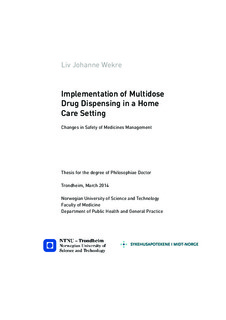| dc.description.abstract | Multidose dispensed drugs are drugs machine-packed into dose unit bags for each time of administration. Trondheim municipality decided in 2005 to implement Multidose Drug Dispensing (MDD) in home care services. At that time, there was a lack of scientific knowledge about the effects of MDD. The health care management of Trondheim therefore decided to study the implementation in collaboration with NTNU. MDD was adopted gradually during 2006. Three studies were conducted with the common main aim of investigating the safety of medicines management during the implementation of MDD. A complex intervention was designed, including both internal and external controls, and pre-post-examinations. Qualitative as well as quantitative data was gathered, forming a method-, data source-, and observer-triangulation.
The introduction of MDD reduced the discrepancies between the medication lists at the general practitioners (GPs), and in the home care services, and even moreso between the GPs and the pharmacies. However, for patients with multidose dispensed drugs, a corresponding improvement also occurred for drugs they received outside the MDD system (e.g. eye drops and inhalers). This finding suggests that new routines, and better collaboration between health practitioners, more than the MDD system by itself, contributed to the improvements. Nevertheless, even if the number of discrepancies between medication lists were reduced, the discrepancies continued to be high, demonstrating that more efforts are needed.
Other reported improvements also occurred. Both the general practitioners and the pharmacists reported a better overview of the patients’ medication and thus a better control. The involved health care practitioners also stated an increased trust in each other, as well as in the MDD system, as better collaboration emerged. However, trust in the MDD system was challenged by a loss of flexibility to make changes in medication/dosage compared to the manual system. The nurses in the home care services expressed that the automation would decrease their knowledge of patients’ drug intake, and thus make them less trusted in observing patients. The GPs believed that electronic communication could improve the exchange of information and updating, and thus produce an even better effect from the MDD system.
The GPs in Trondheim showed a positive attitude to MDD. Increased workload was reported, but still most GPs wanted the system to be continued. The decision to only allow the patient’s GP to prescribe multidose dispensed drugs contributed to the improvements seen in routines of prescription, communication, and cooperation. The decision made the GPs take on a greater responsibility with their patients’ medications, and made the coordination in the MDD system less complex. However, the improved routines and collaboration between GPs and home care services and pharmacies, only related to patients receiving multidose dispensed drugs. The improvements were not transferred to other patients on the GP’s list having drugs administered by the home care services.
The introduction of MDD in Trondheim was followed by improved quality in the medicines management. This thesis shows, however, that the main contribution to improved safety was emphasizing the different steps of the medicines management, to improvements in communication and cooperation between health care practitioners, and the clarifying of roles and responsibilities. The findings cannot be generalized straight forwardly. However, insights from the three studies presented in this thesis should be valid for others planning to implement an MDD system, or already using MDD in the home care services. | |
